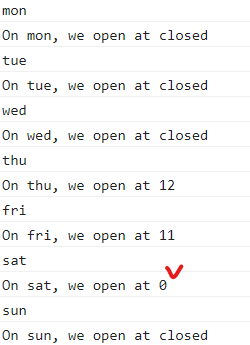| 일 | 월 | 화 | 수 | 목 | 금 | 토 |
|---|---|---|---|---|---|---|
| 1 | 2 | 3 | 4 | 5 | 6 | |
| 7 | 8 | 9 | 10 | 11 | 12 | 13 |
| 14 | 15 | 16 | 17 | 18 | 19 | 20 |
| 21 | 22 | 23 | 24 | 25 | 26 | 27 |
| 28 | 29 | 30 | 31 |
- stylesheet
- 코틀린
- 리액트
- Hook
- Android
- Java
- npm
- 랜덤번호
- 자바스크립트
- nodejs
- JS
- 구글맵스
- TypeScript
- React
- TextView
- 오버라이딩
- GoogleMaps
- SpringBoot
- Kotlin
- Linux
- 스프링부트
- RecyclerView
- 랜덤넘버
- 안드로이드
- Javscript
- fragment
- JavaScript
- scrollview
- array
- button
- Today
- Total
타닥타닥 개발자의 일상
JavaScript / Optional Chaining을 이용해서 코드 훨씬 간결하게 작성하기 + nullish coalescing operator 이용해서 optional chaining 기능 극대화 / '.?' 만 찍으면 끝 본문
JavaScript / Optional Chaining을 이용해서 코드 훨씬 간결하게 작성하기 + nullish coalescing operator 이용해서 optional chaining 기능 극대화 / '.?' 만 찍으면 끝
NomadHaven 2023. 5. 18. 23:41
아래와 같은 코드가 있다고 하자.
아래의 코드에서 object restaurant는 자신의 object 외부에있는 또다른 object인 openingHour를 불러와서 key와 value를 구성하고 있다.
'use strict';
const weekdays = ['mon', 'tue', 'wed', 'thu', 'fri', 'sat', 'sun'];
const openingHours = {
[weekdays[3]]: {
open: 12,
close: 22,
},
[weekdays[4]]: {
open: 11,
close: 23,
},
[weekdays[5]]: {
open: 0, // Open 24 hours
close: 24,
},
};
const restaurant = {
name: 'Classico Italiano',
location: 'Via Angelo Tavanti 23, Firenze, Italy',
categories: ['Italian', 'Pizzeria', 'Vegetarian', 'Organic'],
starterMenu: ['Focaccia', 'Bruschetta', 'Garlic Bread', 'Caprese Salad'],
mainMenu: ['Pizza', 'Pasta', 'Risotto'],
//ES6 enhanced object literals
openingHours,
order(starterIndex, mainIndex) {
return [this.starterMenu[starterIndex], this.mainMenu[mainIndex]];
},
orderDeliver({ starterIndex = 1, mainIndex = 0, time = '20:00', address }) {
console.log(
`Order Received! ${this.starterMenu[starterIndex]} and ${this.mainMenu[mainIndex]} will be deliverd to ${address} at ${time}`
);
},
orderPasta(ing1, ing2, ing3) {
console.log(
`Here is your delicious pasta with ${ing1}, ${ing2} and ${ing3}`
);
},
orderPizza(mainIngredient, ...otherIngredients) {
console.log(mainIngredient);
console.log(otherIngredients);
},
};
만약 외부에서 해당 레스토랑의 월요일(mon) open 시간을 요청한다고 하자.
그렇다면 외부의 요청시간에 답하기 위해서 restaurant 의 openingHour key 값에 있는 월요일(mon) 시간의 value 을 보내야 겠지만,
restaurant object가 사용하는 외부의 openingHour object 내부에는 월요일(mon)의 key 값과 value 값이 없다.
따라서 막무가내로 아래처럼 출력하면
console.log(restaurant.openingHours.mon.open);
이런 오류가 난다.
우선 오류를 피하는게 가장 급한일이라 생각하고, 바쁜대로 undefined 값이라도 보내야 된다고 하자.
if문을 사용해서 아래와 같이 작성할수도 있겠지만,
//restaurant의 open 시간이 있고 open 시간 중 월요일(mon)이 있으면 해당 시간을 출력
if (restaurant.openingHours && restaurant.openingHours.mon) console.log(restaurant.openingHours.mon.open);
Optional Chaining을 이용하면 코드가 훨씬 간단해 진다. 그저 value를 얻고자 하는 속성에 "?"만 붙여주면 된다.
console.log(restaurant.openingHours?.mon?.open);
이제 외부에서 restaurant의 토요일 오픈 시간을 요청한다고 가정해보자.
다행히 openingHours object에서 토요일 값이 설정되어 있어서 요청을 보낼수 있겠다 싶었는데,
const days = ['mon', 'tue', 'wed', 'thu', 'fri', 'sat', 'sun'];
for (const day of days) {
console.log(day);
const open = restaurant.openingHours[day]?.open || 'closed';
console.log(`On ${day}, we open at ${open}`);
}
토요일(sat)의 openinghour이 0시 이고 이 0값은 falsy value라 인식된다.
그래서 거짓으로 인식된 0시의 값 때문에 closed가 출력되고,
On sat, we open at closed라는 예상치 못한 값이 출력되고 만다.
이를 해결하기 위해 nullish coalescing operator를 사용한다. ||대신 ??를 사용하면 된다.
nullish coalescing operator 은 변수가 null 또는 undefined일 때 기본값을 지정하는 데 사용된다.
이 연산자는 변수가 null 또는 undefined인지 확인하고, 그렇다면 지정된 기본값을 반환한다.
그렇지 않으면 변수의 값을 그대로 반환합니다.
이 nuliish coalescing operator의 중요한 특징은 변수가 null 또는 undefined인 경우에만 기본값을 반환하며, 다른 falsy 값인 0, 빈 문자열, false 등은 기본값으로 간주하지 않는다. 따라서 openingHours의 토요일 오픈 시간인 0이 나와도, 0은 기본 값으로 간주되지 않아서 closed가 출력 되지 않는다.
for (const day of days) {
console.log(day);
const open = restaurant.openingHours[day]?.open ?? 'closed';
console.log(`On ${day}, we open at ${open}`);
}
덕분에 토요일에도 0시에 오픈한다는 값이 잘 출력된다.
nullish coalescing operator는 다양하게 이용된다.
method의 유무를 확인 할때도 이용되는데, 아래는 그 예시다
console.log(restaurant.order?.(0, 1) ?? 'Method does not exist');
//order는 존재하는 method 이므로 ['Focaccia', 'Pasta'] 가 출력된다.
console.log(restaurant.orderRisotto?.(0, 1) ?? 'Method does not exist');
//orderRisotto는 존재하지 않는 method 이므로 undefined이 되고, 그로인해 기본값
//Method does not exist 가 출력된다.
배열에 값이 있는지 확인할때도 사용할수 있다.
1.배열에 값이 있을때
const users = [
{ name: 'Nomad', email: 'hello@nomad.io' },
{ name: 'aboc', email: 'aboc@nomad.io' },
];
console.log(users[0]?.name ?? 'User array empty'); //Nomad가 출력된다
console.log(users[1]?.name ?? 'User array empty'); //aboc가 출력된다.
2. 배열에 값이 없을때
const users = [];
console.log(users[0]?.name ?? 'User array empty');
//user[0].name은 undefine 값이므로 User array empty가 출력.
console.log(users[1]?.name ?? 'User array empty');
//user[1].name은 undefine 값이므로 User array empty가 출력.
만약 nullish coalescing operator를 쓰지 않고 if else문을 써서 배열에 값이 있는지 확인하고, 없을 경우 기본값을 출력하도록 설정한다면
if (users.length > 0) console.log(users[0].name);
else console.log('User array empty');이처럼 코드가 몹시 길어졌을 것이다.
nullish coalescing operator를 이용해서 깔끔한 코드를 작성해보자.





